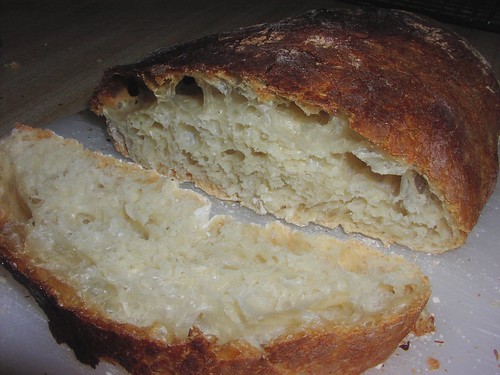
That is a loaf of homemade ciabatta, a type of bread I've been wanting to make for many years now. I've tried making artisan-style bread before, but it just never turned out. Then a friend loaned me Hamelman's book, and everything changed.
Hamelman's book is a reference tome full of information and recipes related to baking bread. While it's aimed at the professional baker (all the recipes have instructors for making dozens of loaves, and Hamelman is the bakery director of King Arthur Flour), he includes sufficient notes (and scaled-down recipes) for the home baker.
The first three chapters are actually completely devoid of recipes. The first chapter (nearly 30 pages) provides detailed instructions for performing every step of making bread, including discussions of the chemistry and biology that's going on during each step of the process. For instance, this is the first book I've seen that discusses what happens chemically as the bread is baking in the oven. Immediately after the bread is put into the oven, the yeast continue fermenting until they die (at ~140F), and the CO2 that's been stored as bicarbonate in the aqueous portion of the bread is also released into the air spaces inside the bread. Both of these processes result in gas production, which means that the bread can rise a lot in the first few minutes after it is put into the oven. However, if the bread forms a crust quickly, it won't be able to rise. Steaming the oven just after the bread has been put in helps prevent the crust from forming, and thus helps allow the bread to rise fully. Steaming also helps keep the crust cool and moist so that amylases in the flour can produce sugars, which will later caramelize and contribute to the flavor and color of the crust.
While Hamelman gets most of his science right (at least as far as I can tell), I'm obligated to point out at least one blunder: he calls yeast a plant. In fact, he says that fungi are a family of plants. While that may have been true in the 1970's, fungi are now their very own kingdom, and they're quite different from plants. In fact, fungi are more closely related to animals than to plants. But Hamelman helped me make a great loaf of bread, and he gets most of his chemistry spot on, so I can forgive a mistake or two.
The second chapter (another 30 pages) discusses all the various ingredients used in bread, and the third chapter (another 30 pages) goes over all the hand techniques used in baking bread. Each technique is illustrated by pen-and-ink drawings that excellently illustrate every step; thanks to this chapter I finally know how to make an oval loaf. While all this introductory material may seem like a lot to read, it's essential, and I'm certain that without this detailed introduction to the science of bread making I couldn't have made the loaf you see pictured above.
The recipes themselves (there are more than 100 of them) are clearly written and easy to follow. The ingredients are listed in a table at the front of the recipe that includes proportions for making either dozens of loaves or only two or three. The instructions are some of the clearest I've seen in a cookbook, though they do assume that you've read the first three chapters. The recipes include everything from baguettes and ciabatta to Irish soda bread, pretzels, and bagels.
So, in short, if you want to make good, artisan-style bread, but haven't been able to, this book may be the very thing you need.
The loaf pictured above is based on Hamelman's ciabatta recipe (page 107-108); it involved a 16 hour poolish fermentation, followed by nearly 4 and a half hours of rising. This was the very first loaf I made from Hamelman's book.
Reference:
Hamelman, Jeffrey. 2004. Bread: A Baker's Book of Techniques and Recipes. Wiley, NJ. 415 pages.



No comments:
Post a Comment